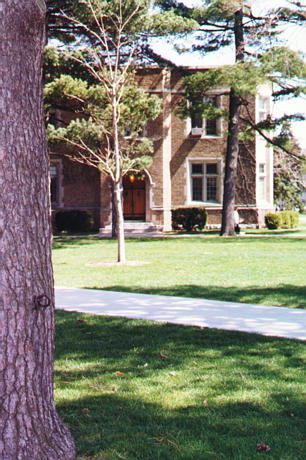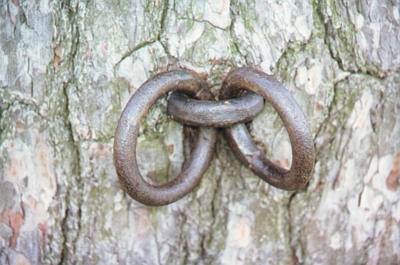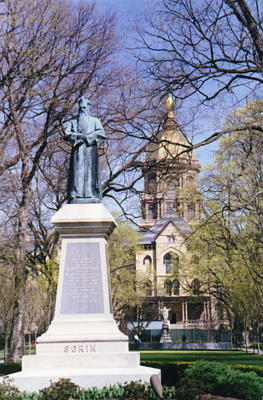
Notre Dame's Grotto / by Dorothy V. Corson

The Mater Admirabilis Statue
History records many interesting written references to Father Sorin's beautiful way with words; his obvious devotion to Our Lady, his indefatigable spirit, and also his determination to have his own way.
Possibly the ultimate example of this audacious aspect of Father Sorin's personality turned up in an 1873 Scholastic :
It seems that Very Rev. Father General in one of his rambles through the studios of Rome came upon a marble statue which an artist was about finishing. It was Mater Admirabilis [Mother Most Admirable]. The subject represents the Blessed Mother in deep meditation, sitting by her spinning-wheel. It has always been V. R. F. Sorin's favorite representation of the Blessed Virgin. Of course he wanted it -- wanted it, right away. There was only one little obstacle to his getting it. The artist regretted to inform him that the statue was intended for the Holy Father. Well, this was rather an obstacle. Many a one would have given up the idea of ever getting the Mater Admirabilis. Not so Father General. He recommended his petition to the artist himself, and on his side prepared for a vigorous attack. But we will let him relate the incident. After speaking of several objects of art which he has purchased in Rome he speaks of this statue in a letter home:
The second is marble, a Mater Admirabilis, which was being made for the Pope: Today at 113/4 a.m. we go to a private audience: if I can prove to the Holy Father that I love very much his chosen model, etc., he may let me carry it away: I am preparing my speech.
July 2 -- Yesterday, at last, I had an audience, more delightful, if possible, than any of the nine audiences I received before. The Holy Father was more of a father to me than I had ever seen him since twenty years. A few moments afterwards, the artist, one of the first sculptors in Rome went to the Vatican with his splendid Mater Admirabilis to present it to his Holiness as a token of his veneration. (I have the following little incident in writing, from the sculptor himself.)
"But, most holy Father," said the artist, "here is the card of an American Missionary who came to my studio while I was finishing this your graceful and favorite design; I told him it was for your Holiness. I was giving it the last touch; he looked at it none the less attentively. It appears, most Holy Father, it pleased him so much that he declared he must have it. Those Americans are so positive!"
I answered; "if his Holiness permits!"
"Ah! -- Padre Sorin! -- certainly, with pleasure. I bless it for him; let him have it."
Sorin ends his letter with, I have the pleasure to announce to you that it is to be shipped this morning for Notre Dame [August , 1873].(63)
While it was an amusing incident, it left little doubt of his penchant for realizing his goals. Joseph White, author of the Sacred Heart Parish history, recounts another example of Sorin's philosophy when a close examination revealed a foot-long crack in the old church's largest bell:
Sorin reported that "a wise head" -- probably Sorin himself -- "trusting more than the rest in the Blessed Queen of the place" suggested that the broken bell be replaced by another, four times, or even five times larger, positively declaring that, while few persons would feel inclined to subscribe anything for an ordinary bell, many would be delighted to contribute for the acquisition of an extraordinary one.(64)
With characteristic determination he pursued the effort and raised the funds for the bell, which required four men to ring it. It arrived the summer of 1867, but turned out to be too large for the early church. It was placed a short distance away in a separate ground level belfry. While it may have been comical at the time, ten years later it was perfectly suited for the new church where it resides to this day impressing everyone who has seen it.
This uncanny ability Sorin had to triumph in the end was very like what has been attributed to an atmosphere on campus: "a certain force -- an energy allowed each person to perform on a level higher than usual. It came to be called the God loop. It provided good luck when least expected."(65)
It was Father Sorin himself who said, "There are moments when a vigorous stand upsets the enemy!" The enemy to Sorin was fire, pestilence, lack of funds, and anyone who didn't want to do things his way. He also said, "You can only do good by risking it." And risk it he did, on many occasions. As Father Hope put it , "there were times when Fr. Sorin was just one jump ahead of the sheriff." Yet it does seem that many of his bold actions were the result of pushing his faith to the limit to prove to himself, and others, what unbounded faith can accomplish.

|
As Father Hope has put it, "It is not wholly irreverent to say that Father Sorin was a tyrant. Tyrannical he was and no doubt, many were the toes stepped on. But all, in all, his energy was so great, his vision so clear, his personality so impressive, that the imposition of his will cannot be said to have been a bad thing."(66) What he is said to have lacked in common sense, he made up for with a terrific imagination. His boundless energy emanates from words written by him and about him. It has been said that, "The world steps aside for a man who knows where he's going," Sorin certainly had that quality.
|
Another example of Fr. Sorin's perseverance was his appointment as Postmaster of a Post Office at Notre Dame. In his Chronicles he wrote: "The regular passage of the mail coach would make the college better known, and causes the public highways leading to it to be carefully maintained." [guoted in Arthur Hope, Notre Dame 100 Years (Notre Dame: University Press, 1948), p.74] It would also bring revenue for the college. On January 6, 1851 after a prior attempt failed, Fr. Sorin was made Postmaster of a postal station at Notre Dame. His interest in the upkeep of the roads around Notre Dame also prompted him to seek and gain an appointment as Inspector of the Public Ways.
Evidence of the site of the original Notre Dame Post Office still remains today in the hitching rings shown in these photographs. Undoubtedly, Sorin himself used these same hitching rings. They are located in a group of pine trees about 100 feet east of Sorin's statue in front of Hurley Hall.

Sorin was not alone in his mission, nor in his determination to fulfill his goals. Mother Angela -- whose very presence at Notre Dame, according to Father Hope, was a "religious hijacking" by Sorin -- was on her way to join another religious order when Father Sorin convinced her to join the Sisters of the Holy Cross. History records that she also had her own unique destiny to fulfill and her own characteristic way of accomplishing it.
A similar reference to Mother Angela's own strong personality is in a collection of letters at the University Archives. This unguarded forthright estimation of the human side of Mother Angela's personality is interesting in terms of the universality of human nature. It was written by a general's wife, a reliable source, who was related to Mother Angela and knew her intimately. The general's wife was writing to her husband about their daughter's forthcoming trip to Europe and Mother Angela's wish to go with her. She speaks of their daughter and her "unwillingness that she not be harassed by her presence."
She would embarrass and annoy her in many way . . . for Mother Angela is unreasonable in her demands upon others and she is moreover totally ignorant of the duties of those not in her own sphere. . . . Please do not intimate that I have written in this way. (67)
Had some of Sorin's forceful personality rubbed off on Mother Angela?
The general's wife apparently accomplished her aim. The letter was written in 1873 the same year the General's daughter, Mother Angela and Father Sorin went separately to Europe and the Grotto of Lourdes, each with their own traveling companion. It was during this same trip, in August of 1873, that Sorin went to Rome and talked the Pope out of his Mater Admirabilis statue.
The Scholastic reported that another Mater Admirabilis statue was received at St. Mary's a month later, on September 13, 1873. It was sent from Europe by Mother Angela during that same trip. Father Sorin's was marble and Mother Angela's a pleasing and colorful painted statue. The existence of Father Sorin's is unknown, while the one Mother Angela sent home is still located near the South Window of the 4th floor hallway of Bertrand Hall.
As the stories told about Sorin have served to humanize him, it seems only fair that this one hundred and twenty-two year old slice of life be shared to humanize Mother Angela. Perhaps it is also only fair to conclude, that Notre Dame and St. Mary's might never have existed without two such strong autocratic personalities to found them.
Father Sorin, himself, mentioned the importance of recording a true unedited history in his own reflections recorded in his Chronicles :
. . . If these annals are to be considered as a truthful history they must either speak the truth or be silent, unless it be understood that they show only the fair side. But that would not be doing justice to the institute, nor even to the actions of Providence; because unless we see the obstacles and the difficulties of all kinds that have been met, it will not be possible to appreciate the triumph of grace. Moreover, those miseries contain lessons and warnings which will at least not be useless for our successors.(68)
The association of Father Sorin and Mother Angela was covered very nicely in Sister M. Georgia Costin's book, Priceless Spirit. "Sorin saw the great design; Angela supplied the details. He was the architect, she was the contractor." (69)
